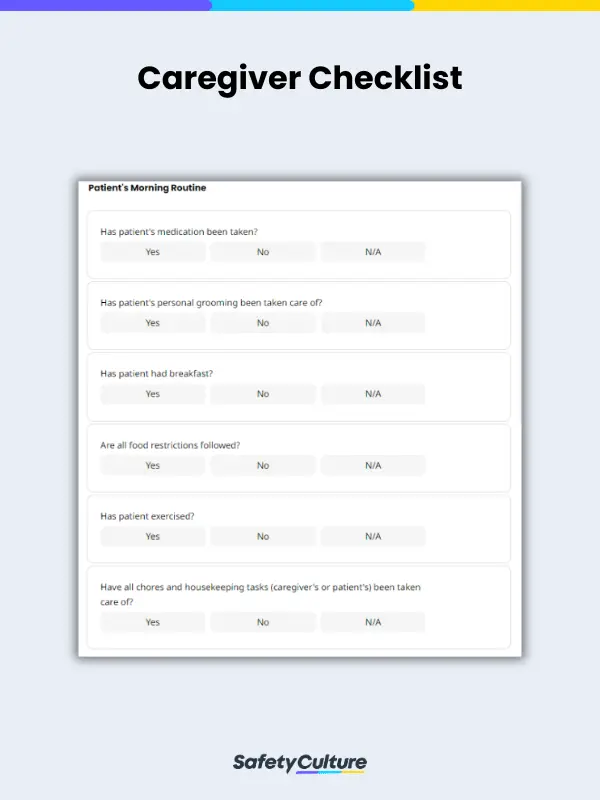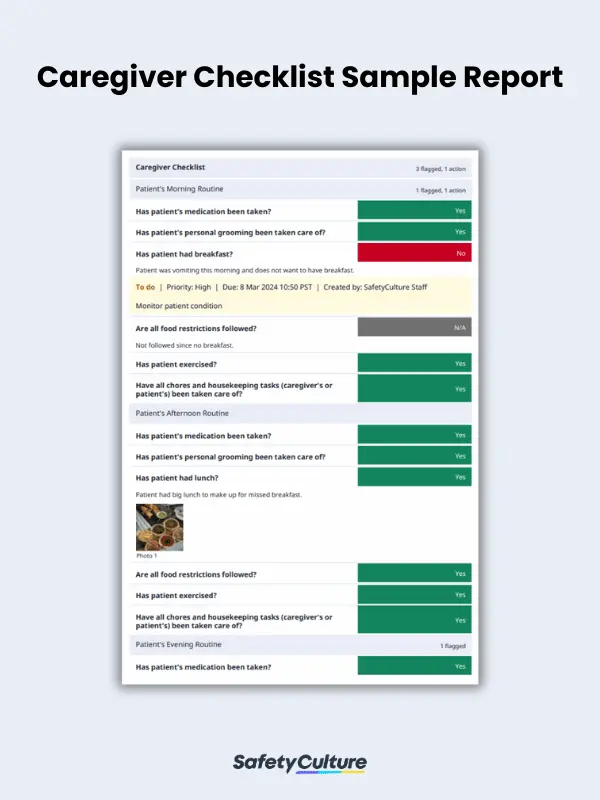What is a Caregiver Checklist?
A caregiver checklist is a detailed document that outlines the various tasks and responsibilities a caregiver needs to do to meet the needs of the person they are caring for. This checklist typically covers health monitoring, medication management, personal care, meal planning, mobility and exercise, and specialized care, depending on the patient’s condition. It’s commonly utilized in nursing homes, adult daycare centers, home health care, assisted living facilities, hospitals, hospices, and respite care settings.
Why is a Checklist Important to a Caregiver?
Using a caregiver checklist offers numerous benefits for both caregivers and care recipients in nursing homes, elderly care homes, and their own private homes. These checklists help caregivers handle their duties with accuracy and compassion, ensuring that the needs of the patient are met effectively and in a timely manner.
In particular, caregiver checklists provide a structured approach to caregiving by outlining all necessary tasks and responsibilities, ensuring that no essential aspect of care is overlooked.
Some important aspects of caretaking that a caregiver checklist helps standardize include the following:
- Time medication should be administered
- Dosage of medication
- Symptoms of pain to look out for
- Eating, grooming, and exercising schedules
- Dietary needs and considerations
By using a checklist to keep track of all tasks that need to be done, a caregiver can work more efficiently and effectively, reducing stress that can come from missing a task or doing it wrong. It helps manage time and organize tasks, as the provided structure reduces the risk of overlooking essential duties, ensuring a more organized approach to care.
A caregiver checklist can also help in facilitating interactions between the caregiver and their ward. It serves as formal documentation and a communication tool between caregivers, family members, and healthcare professionals to maintain clarity about the caregiver’s ward’s needs and progress.
How to Create This Checklist
To create a caregiver checklist that will work for the caregiver’s needs, caregivers need to follow these steps:
1. Understand the patient’s condition and needs.
Before creating the checklist, the caregiver must know their ward and their family well. They need to know the specific needs, routines, and preferences of the individual receiving care before anything else, as this will affect how the checklist will be made.
They should also consult with the right healthcare providers to understand specific care requirements, chronic illnesses, or disabilities they need to prepare for.
2. Explore individual preferences and options.
After familiarizing themselves with their wards, caregivers must then familiarize themselves with their ward’s preferences regarding meals, laundry, shopping, and bathing, and respect cultural and religious beliefs. These should also be considered in creating the caregiver checklist.
3. Create the checklist.
Once the caregiver has gotten to know their ward well, they can proceed with the checklist. While this is often made by the caregiver themselves, this can also be done with the ward and their family. In some cases, their doctors are also involved.
The checklist will document the patient’s specific needs and preferences alongside emergency contacts, relevant medical providers’ information, and health insurance details securely.
To make this process easier, caregivers can use digital caregiver checklists for easy customization and remote monitoring capabilities to enhance task management and accessibility.
What to Include in a Checklist for Caregivers
Different caregivers and patients will have different needs, thus leading to different checklists. However, a typical caregiver checklist will have fields for the following:
- Name of caregiver on duty
- Date the checklist is being used
- Name of patients
- Patient’s morning, afternoon, and evening routines, such as:
- Taking medication and vital signs
- Eating food and drinking water
- Exercising as needed
- Personal care tasks
- Other habits they may need to keep up with
- Housekeeping tasks to do
- Changes in patient’s condition, if any
At the end of the checklist, it would be best to add a field to have caregivers sign off to ensure nothing is amiss. Additionally, having the option to add comments to each field at the end of the checklist will also help note points of concern.
Here is a caregiver checklist sample for reference:
Common Types
While caregiver checklists are often known for being daily-use documents, there are other types available for more specific uses. These checklists can be used with daily caregiver checklists for more detailed tasks.
Some of the most common ones include:
- Medication checklists
- Meal preparation checklists
- Personal grooming checklists for both caregivers and wards
- Housekeeping checklists for both caregivers and wards
FAQs about Caregiver Checklists
The families of wards and patients can also use a caregiving checklist alongside the caregiver. Having access to the caregiving checklist can keep family members updated on the patient’s well-being as well as the caregiver’s performance.
As caregiving needs may change over time, it would be best for caregivers to have the option to edit their checklists regularly. The best way to do so would be to have a digital caregiver checklist hosted on a platform that can be accessible from anywhere for easy changes.
Some common challenges when using a caregiver checklist include:
- Feelings of overwhelm and stress if the checklist is not easily understood
- Documentation of all tasks and processes in a timely manner
- Time management
- Consistency in using the checklist




